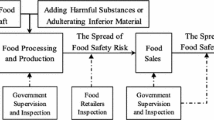Abstract
According to the Centers for Disease Control and Prevention, approximately 48 million people experience foodborne illnesses per year. The majority of the illnesses are attributed to the presence of bacteria in food products. However, there is some concern about the likelihood of food contamination resulting from intentional acts of sabotage. This research presents a stochastic model to quantify food supply chain vulnerability in terms of the number of people who become ill from consuming a contaminated food product. We specifically use a discrete time, discrete state Markov chain model with rewards and estimate consumer illness by product and distribution channel. The results of our computational study show the relationship between purchasing behavior, product shelf life, and consumer risk. We propose a classification scheme that can be used to categorize the level of vulnerability among different food distribution channels. We also show the impact of purchasing behavior on the speed with which the products are sold at each distribution channel. The proposed model has the potential to provide insight into timely interventions and influence how intervention policies would need to be tailored to each distribution channel in the event that a chemical contamination occurs.











Similar content being viewed by others
References
Agency for Toxic Substances and Disease Registry (2010) Toxicological Profile for Ethylene Glycol. U.S. Department of Health and Human Services, Public Health Service, Atlanta, GA.
Buchanan RL, Smith JL and Long W (2000) Microbial risk assessment: dose-response relations and risk characterization. International Journal of Food Microbiology 58 (3), 159–172.
Centers for Disease Control and Prevention (2003) Nicotine poisoning after ingestion of contaminated ground beef-michigan. Morbidity and Mortality Weekly Report 52(18), pp 413–416.
Centers for Disease Control and Prevention (2011) CDC estimates of foodborne illness in the United States. [WWW document] http://www.cdc.gov/foodborneburden/PDFs/FACTSHEET_A_FINDINGS_updated4-13.pdf (accessed 30 March 2015).
Centers for Disease Control and Prevention (CDC) (2015) Surveillance for foodborne disease outbreaks,United States 2013, annual report. Technical report, US Department of Health and Human Services, Atlanta, GA.
Chang Y, Zhang Y, Erera AL and White C (2012) Vulnerability assessment of a food supply chain to an intentional attack. In Homeland Security (HST), 2012 IEEE Conference on Technologies for, pp 319–324. IEEE, Waltham, MA.
Chen Y et al (2013) FDA-iRISKa comparative risk assessment system for evaluating and ranking food-hazard pairs: case studies on microbial hazards. Journal of Food Protection® 76 (3), 376–385.
Dalziel GR (2011) Assessing the terrorist threat to the food supply: food defence, threat assessments, and the problem of vulnerability. International Journal of Food Safety, Nutrition and Public Health 4 (1), 12–28.
FDA (2013) FDA authorizes sunland to resume preparing and distributing food at peanut butter plant. [WWW document] http://www.fda.gov/Food/RecallsOutbreaksEmergencies/Outbreaks/ucm320413.htm (accessed 30 March 2015).
Food and Drug Administration(FDA) (2007) An integrated strategy for protecting the nation’s food supply. [WWW document] http://www.fda.gov/Food/GuidanceRegulation/FoodProtectionPlan2007/ucm132565.htm (accessed 10 August 2012).
Hartnett E, Paoli GM and Schaffner DW (2009) Modeling the public health system response to a terrorist event in the food supply. Risk Analysis 29 (11), 1506–1520.
Holcomb DL, Smith MA, Ware GO, Hung Y-C, Brackett RE and Doyle MP (1999) Comparison of six dose-response models for use with food-borne pathogens. Risk Analysis 19 (6), 1091–1100.
Howard R (1960) Dynamic Programming and Markov Processes. MIT Press, Cambridge, MA.
Jaine A (2005) A predictive modeling and decision making tool to facilitate government and industry response to an intentional contamination in the food supply. In Proceedings of the Institute of Food Technologists first annual food protection and defense research conference, p 1, http://www.ift.org/~/media/Knowledge%20Center/Science%20Reports/Conference%20Papers/14Jaine.pdf.
Johnson R (2014) Food fraud and economically motivated adulteration of food and food ingredients. Congressional Research Service, Retrieved from http://www.fas.org/sgp/crs/misc/R43358.pdf.
Kao E (1997) An Introduction to Stochastic Processes, Duxbury Press, Belmont, CA.
Kuo H-S, Chang H-J, Chou P, Teng L and Chen T (1999) A markov chain model to assess the efficacy of screening for non-insulin dependent diabetes mellitus (niddm). International Journal of Epidemiology 28 (2), 233–240.
Liu Y and Wein L (2008) Mathematically assessing the consequences of food terrorism scenarios. Journal of Food Science 73 (7), M346–M353.
Marucheck A, Greis N, Mena C and Cai L (2011) Product safety and security in the global supply chain: issues, challenges and research opportunities. Journal of Operations Management 29 (7), 707–720.
Mohtadi H and Murshid AP (2009) Risk analysis of chemical, biological, or radionuclear threats: implications for food security. Risk Analysis 29 (9), 1317–1335.
Noblis (2009) Predictive toxicity measures for fifteen model chemicals: derived for three potential routes of exposure and four categories of injury severity. Technical report, Noblis Incorporated, Falls Church.
Pinior B, Conraths FJ, Petersen B and Selhorst T (2015) Decision support for risks managers in the case of deliberate food contamination: the dairy industry as an example. Omega 53, 41–48.
Teasley R (2013) Are we sick yet: assessing consumer morbidity from food contamination in multiple distribution channels. Master’s thesis, North Carolina Agricultural and Technical State University, Greensboro, NC.
USDA (2015) Summary of recall cases in calendar year 2014. [WWW document] www.fsis.usda.gov/wps/portal/fsis/topics/recalls-and-public-health-alerts/recall-summaries/recall-summaries-2014 (accessed 30 March 2015).
Wein LM and Liu Y (2005) Analyzing a bioterror attack on the food supply: the case of botulinum toxin in milk. Proceedings of the National Academy of Sciences of the United States of America 102(28), 9984–9989.
Whiting RC and Buchanan RL (1997) Development of a quantitative risk assessment model for salmonella enteritidis in pasteurized liquid eggs. International Journal of Food Microbiology 36 (2), 111–125.
Acknowledgements
This material is based on work supported by the U.S. Department of Homeland Security under Award Number:A13-0061-001.
Author information
Authors and Affiliations
Corresponding author
Additional information
Disclaimer
The views and conclusions contained in this document are those of the authors and should not be interpreted as necessarily representing the official policies, either express or implied, of the U.S. Department of Homeland Security.
Rights and permissions
About this article
Cite this article
Teasley, R., Bemley, J., Davis, L. et al. A Markov chain model for quantifying consumer risk in food supply chains. Health Syst 5, 149–161 (2016). https://doi.org/10.1057/hs.2015.16
Received:
Revised:
Accepted:
Published:
Issue Date:
DOI: https://doi.org/10.1057/hs.2015.16




